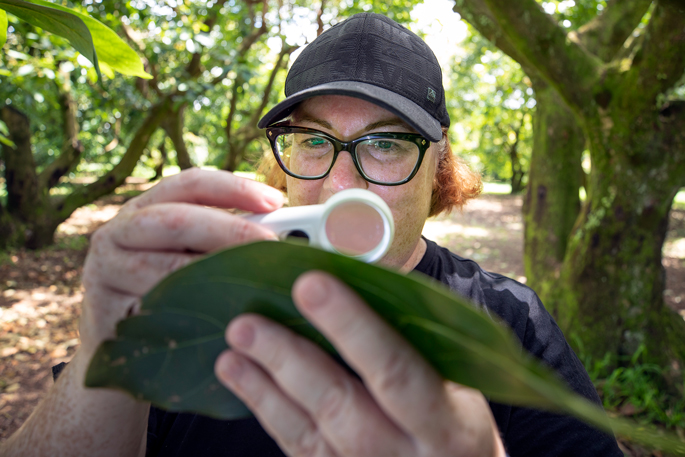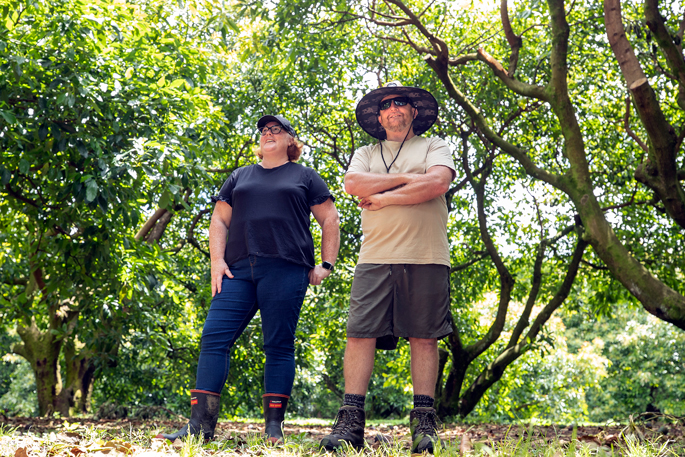It’s been a steep learning curve for John and Alicia Ludemann, who’ve turned a neglected property into a thriving orchard.
As newbie orchardists, they’ve embraced challenges and learned from mistakes to achieve sustainable success.
It was March 2017 when they decided move from Queensland, Australia, to Katikati.
“I was looking for a dual income property with kiwifruit and avocados and enough land for stock so we could feed ourselves,” says John.
“This property at 10.11ha had both crops and some bare land so we could build the house and shed that we wanted.”
Their property is divided into about 2ha of Hayward green kiwifruit, 365 avocado trees on around 2.64 canopy hectares with space for cattle and sheep.
Avocados ourselves
“At first, only the kiwifruit was under management, but we always wanted to be hands-on, so we took over the avocados ourselves straight away,” says John.
“The previous owners had neglected the avocados for about 10 years. They hadn’t been fertilising or pruning,” says Alicia.
“We threw ourselves into learning and signed with Trevelyan’s. The technical support we’ve got from them has been so helpful. We wanted to be environmentally sustainable.”
Regenerative farming aims to make farms stronger, starting with the soil.
“We try to limit our footprints and compaction on the orchard,” says Alicia.
“We don’t use heavy machinery other than for spraying or harvesting with pickers. We limit the times we mow, which cuts down on fuel and helps retain biodiversity. We incorporate compost in our fertiliser programme and that helps with mycelium, which is the main fungi that avocados require to uptake all their nutrients.”
Pruning
“We do a structural prune every year, then John just prunes as needed. We add seaweed with Stimplex into our sprays to help the trees recover and to encourage beneficial bugs. One reason I completed my AvoGreen certification was to become more accurate with spray application times. One ladybug can eat up to a hundred six-spotted mites in a day.”
Biodiversity gives ladybugs and other insects something to forage.
 Alicia Ludemann checking for pest such as six-spotted mites on the underside of leaves on an avocado tree. Photo: John Borren/SunLive.
Alicia Ludemann checking for pest such as six-spotted mites on the underside of leaves on an avocado tree. Photo: John Borren/SunLive.
“For the first few years we did put a lot of fertiliser on to build soil health,” says Alicia.
“Now, we can fertilise and compost a handful of times through the year. We’re trying to be innovative, so we use a PFP lime that has humates. John can spread it himself and it absorbs into the soil better and is better for our pH.”
It took four years to improve the health of the avocados. From a yield of 30 bins in their first year, John and Alicia now average 110 bins annually. “The avocados were really sick,” says Alicia.
Precise
“In fact, when we bought the property we were told to rip them out, but we wanted to learn from them.”
For John and Alicia, it’s a balance of regenerative practices and commercial needs.
“We don’t spray if we don’t have to,” says Alicia.
“We don’t fertilise as much because we incorporate organic practices like composting and reducing our impact by not mowing or using heavy machinery. We don’t even own a tractor.”
John and Alicia’s aim is to achieve a consistent 150 bins of fruit every year by carrying out a radical structural prune in winter followed by light pruning as needed.
“We’ve done well with the avocados. They’re now very healthy trees.”



0 comments
Leave a Comment
You must be logged in to make a comment.